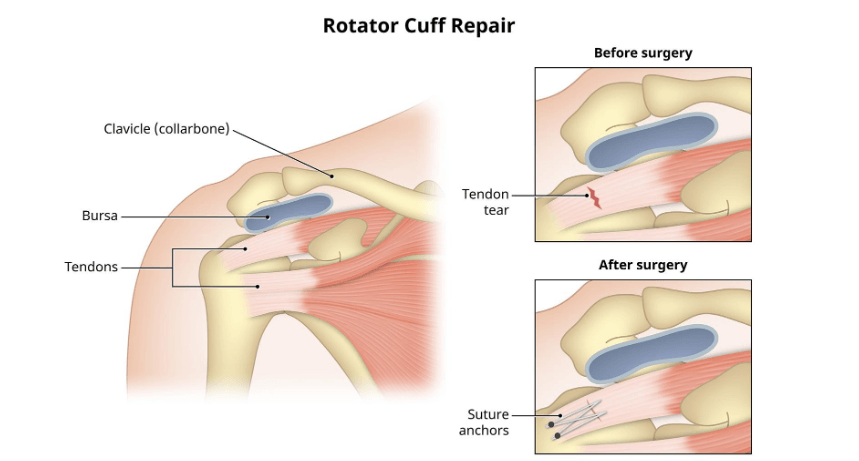What is RC Tear?
A rotator cuff tear is a common injury that affects the group of muscles and tendons surrounding the shoulder joint. These muscles and tendons work together to stabilize and move the shoulder joint. The rotator cuff is composed of four main muscles:
Supraspinatus: Located on the top of the shoulder blade and helps with lifting the arm away from the body (abduction).
Infraspinatus: Situated on the back of the shoulder blade and aids in rotating the arm outward (external rotation).
Teres minor: Located below the infraspinatus and also assists with external rotation.
Subscapularis: Found on the front of the shoulder blade and helps with rotating the arm inward (internal rotation).
Patient's Symptoms
A rotator cuff tear can occur due to sudden trauma or as a result of repetitive strain and wear over time. There are two main types of rotator cuff tears:
Partial-thickness tear: In this type, only a portion of the rotator cuff tendon is damaged.
Full-thickness tear: This is a more severe tear where the tendon is completely torn, separating it from the bone it attaches to.
Symptoms: The symptoms of a rotator cuff tear can vary depending on the severity of the tear, but common signs include:
Pain: Usually felt on the front or side of the shoulder, which may radiate down the arm.
Weakness: Difficulty in lifting or rotating the arm.
Limited range of motion: Reduced ability to move the shoulder freely.
Clicking or popping sensation: Some people may experience this when moving the shoulder.

Treatment
Treatment: The treatment for a rotator cuff tear depends on various factors, including the size and location of the tear, the patient’s age and activity level, and the overall health of the shoulder joint. The treatment options include:
- Conservative management
- Corticosteroid injections
- Surgical intervention: For larger tears or cases where conservative treatments haven’t been successful, surgery may be considered. The surgical procedure may involve arthroscopic techniques to repair the torn tendon or, in more severe cases, open surgery.
Arthroscopic RC Repair: The arthroscope will be put inside the shoulder through a small incision, other 1 or 2 minute incisions will be made to introduce other small grasping, probing or cutting tools.
Injured tendons and muscles will be cleaned arthroscopically and tear identified. The torn tendons and the bone at attachment site are prepared. The tendon and muscle will be brought to their original position and held there with help of 2-3 anchors (small screws with thread attached to it).
Anchors can be metallic made of titanium or non metallic.
Non metallic can be either be bio-absorbable, bio composite, Bio inert like PEEK.
There are various ways of fixing it, mainly single row or double row repairs depending on the age and the tear pattern.
Younger patient with larger tear and demanding jobs are better off with double row repairs.
Rehab and Recovery
The shoulder will be immobilized in a sling or immobilizer before you go home. At home, its important to keep the surgical site area clean & dry.The dressing/surgical stitches will be removed after 2 weeks during a follow up visit. ROM exercises of elbow & wrist are to be carried out as advised by physiotherapist to prevent stiffness. You Should expect to be in sling for about 6 weeks. Active assisted ROM exercises are started at 6 weeks followed by Stretching of shoulder muscles using a low resistance treatment. Full movement is expected at 3 months. Total rehab last for 6 months which is when a player can take up any sport activity.
